2nd International Workshop of Ubiquitous Computing & Ambient Intelligence (wUCAmI’06), University of Castilla La Mancha, pp. 83-95, November, 2006.
Abstract
La tecnología RFID, que permite la identificación única de cualquier ser u objeto sin necesidad de contacto ni línea de visión directa, se está adoptando ampliamente en todo tipo de campos al producir un salto cualitativo en la integración de la informática con el entorno. En este artículo se muestra su estado del arte y se afrontan dos soluciones orientadas a paliar las necesidades en entornos sanitarios. Por un lado, un sistema de seguimiento de dispositivos en el interior de un centro médico que permite su localización inmediata y la prevención de hurtos usando RFID pasivo UHF con un testeo de fiabilidad, y por otro, una solución de control y atención de pacientes ingresados en planta usando RFID pasivo HF obteniéndose un demostrador plenamente funcional
Digital Privacy: Theory, Technologies, and Practices, A.. Acquisti, S. Gritzalis, C.. Lambrinoudakis, and S. De Capitan di Vimercati Eds., Auerbach Publications, pp. 285-306, December, 2007.
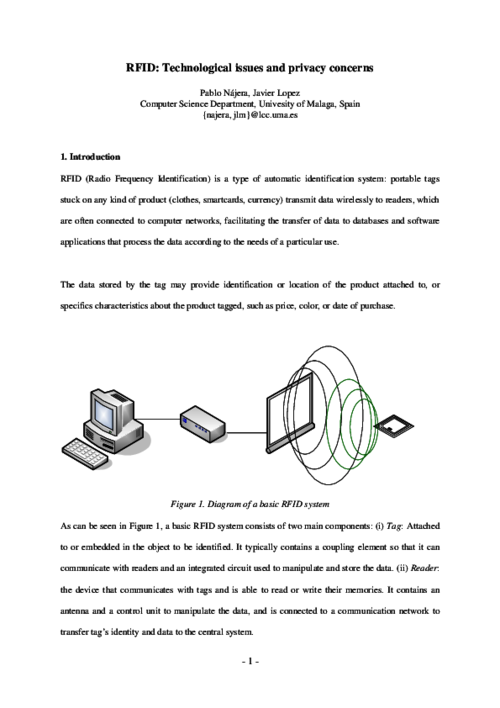
3rd Symposium of Ubiquitous Computing and Ambient Intelligence 2008, Advances in Soft Computing 51/2009, Springer, pp. 134-138, October, 2008. DOI
Abstract
Seamless human identification and authentication in the information system is a fundamental step towards the transparent interaction between the user and its context proposed in ambient intelligence. In this context, the IDENTICA project is aimed to the design and implementation of a distributed authentication platform based on biometrics (i.e. voice and facial image) and personal documentation. In this paper, we present our work in this project focused on the secure integration of RFID technology in personal documentation in order to provide seamless identity validation. Our actual work status, first results and future directions are described in detail.
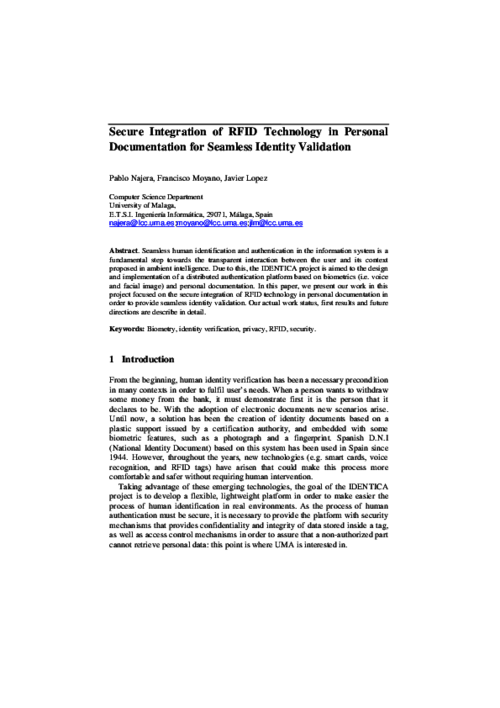
Journal of Universal Computer Science, vol. 15, pp. 970-991, 2009. DOI
Abstract
Traditional paper documents are not likely to disappear in the near future as they are present everywhere in daily life, however, paper-based documentation lacks the link with the digital world for agile and automated processing. At the same time it is prone to cloning, alteration and counterfeiting attacks. E-passport defined by ICAO and implemented in 45 countries is the most relevant case of hybrid documentation (i.e. paper format with electronic capabilities) to date, but, as the advantages of hybrid documentation are recognized more and more will undoubtedly appear. In this paper, we present the concept and security requirements of general-use e-documents, analyze the most comprehensive security solution (i.e. ePassport security mechanisms) and its suitability for general-purpose e-documentation. Finally, we propose alternatives for the weakest and less suitable protocol from ePassports: the BAC (Basic Access Control). In particular, an appropriate key management infrastructure for access control to document memory is discussed in conjunction with a prototype implementation.
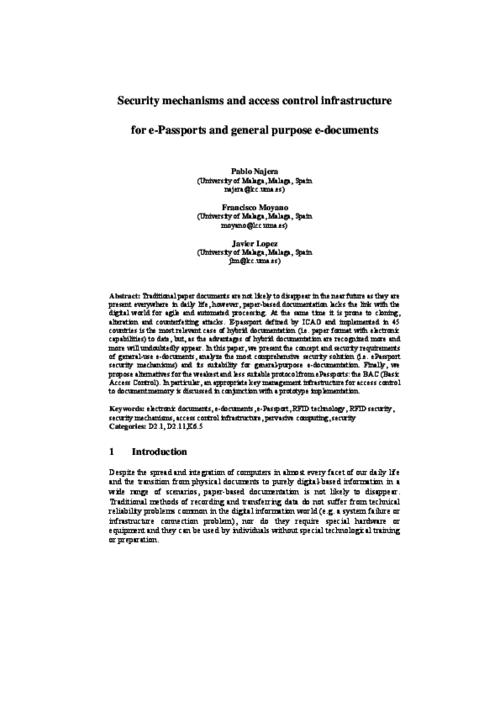
XI Reunión Española sobre Criptología y Seguridad de la Información (RECSI 2010), pp. 337-342, September, 2010.
Abstract
Las Infraestructuras Críticas (ICs) son monitorizadas por sistemas altamente complejos, conocidos como sistemas SCADA (Sistemas de Control y Adquisición de Datos), cuyo principal soporte se encuentra en las subestaciones, las cuales miden de primera instancia el estado real de tales ICs. Para mejorar este control, la industria está actualmente demandando la integración en el modelo tradicional de dos avances tecnológicos: Internet y las redes de sensores inalámbricas. Sin embargo, su incorporación requiere analizar los requisitos de seguridad que surgen en dicho contexto, así como diversos aspectos correlacionados (ej. mantenimiento, rendimiento, seguridad y optimización) y, en base a estos, la estrategia de integración más adecuada para satisfacer dichos requisitos. Este artículo proporciona dicho análisis en profundidad con el fin de ofrecer un modelo de integración seguro adecuado para entornos críticos.
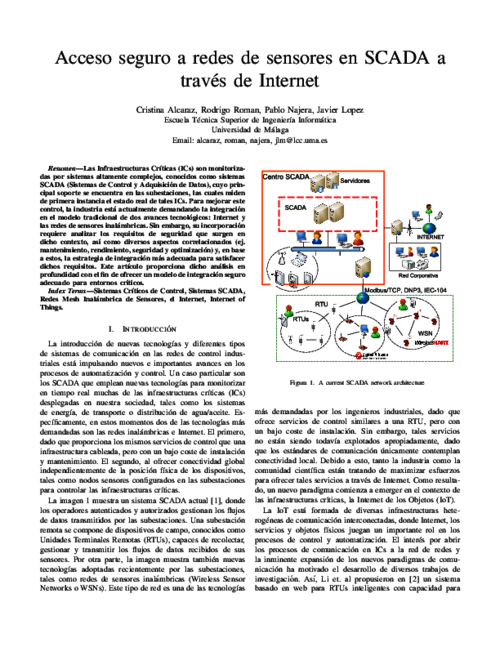
Revista SIC, vol. 88, Ediciones CODA, pp. 66-73, Feb 2010.
Abstract
El paradigma de la Internet de los Objetos, donde todos aquellos objetos físicos que nos rodean tendrán la capacidad de generar y consumir información en el ámbito de un mundo virtual, se encuentra cada vez más cerca. Es ahora un buen momento para llamar la atención sobre sus principales desafíos de seguridad, tanto desde un punto de vista global como asociados a sus elementos más importantes (la tecnología RFID y las redes de sensores). Así, este paradigma puede ser plenamente comprendido y protegido, evolucionando hacia uno de los nuevos pilares del futuro.
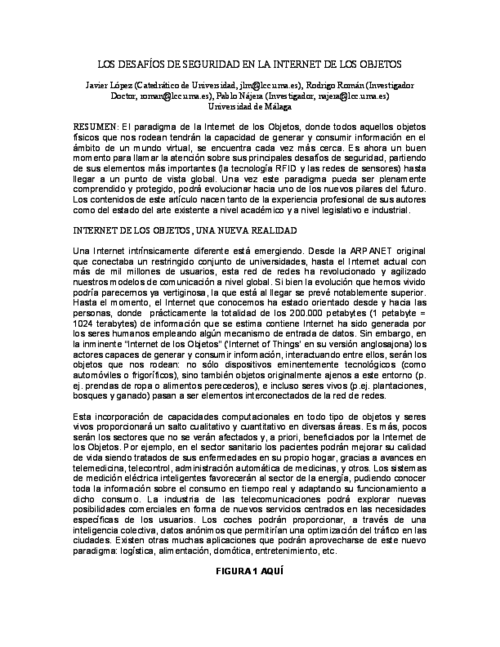
1st International Workshop on the Security of the Internet of Things (SecIoT’10), IEEE, pp. xxxx, December, 2010.
Abstract
Wireless sensor networks (WSN) behave as a digital skin, providing a virtual layer where the information about the physical world can be accessed by any computational system. As a result, they are an invaluable resource for realizing the vision of the Internet of Things (IoT). However, it is necessary to consider whether the devices of a WSN should be completely integrated into the Internet or not. In this paper, we tackle this question from the perspective of security. While we will mention the different security challenges that may arise in such integration process, we will focus on the issues that take place at the network level.
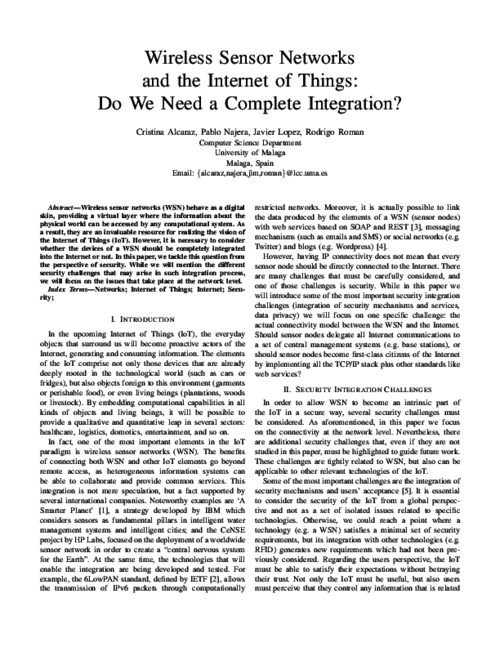
X Jornadas de Ingeniería Telemática (JITEL 2011), K. Hackbarth, R. Agüero, and R. Sanz Eds., Universidad de Cantabria, pp. 104 - 111, 09/2011.
Abstract
El paradigma de red personal (PN) permitirá la interacción y colaboración del creciente abanico de dispositivos personales. Con tal fin la PN ha de integrar en su seno múltiples tecnologías heterogéneas con diversas capacidades computacionales y de comunicación de forma segura. En particular, la incorporación de la tecnología RFID en objetos personales conlleva múltiples riesgos de seguridad y privacidad que han suscitado un elevado interés de la comunidad investigadora en los últimos años. Más allá de su seguridad de forma aislada, su integración en la PN y la interacción de ésta con redes de área extensa como Internet of Things requieren una arquitectura de red personal adecuada para tal contexto. Este artículo proporciona los fundamentos de tal arquitectura segura incluyendo el análisis de aspectos como la incorporación e inicialización de las restringidas etiquetas RFID en la red personal, la autenticación tanto de miembros de la PN como de usuarios y servicios remotos en su acceso a las tecnologías de contexto, el control de las políticas de privacidad y el establecimiento de canales seguros de comunicación supervisados.
Wireless Communications and Mobile Computing, vol. 11, Wiley, pp. 267-276, 2011. DOI
Abstract
The wireless sensor networks (WSN) paradigm is especially vulnerable against external and internal attacks. Therefore, it is necessary to develop security mechanisms and protocols to protect them. These mechanisms must become an integral part of the software architecture and network stack of a sensor node. A question that remains is how to achieve this integration. In this paper we check how both academic and industrial solutions tackle this issue, and we present the concept of a transversal layer, where all the different security mechanisms could be contained. This way, all the elements of the architecture can interact with the security mechanisms, and the security mechanisms can have a holistic point of view of the whole architecture. We discuss the advantages of this approach, and also present how the transversal layer concept was applied to a real middleware architecture.

Digital Home Networking, R. Carbou, E. Exposito, and R. Roman Eds., Wiley-ISTE, pp. 17 - 58, 2011.
Journal of Network and Computer Applications, vol. 34, Elsevier, pp. pp. 980-989, 2011. DOI
Abstract
RFID technology meets identification and tracking requirements in healthcare environments with potential to speed up and increase reliability of involved processes. Due to this, high expectations for this integration have emerged, but hospital and medical centers interested in adoption of RFID technology require prior knowledge on how to squeeze RFID capabilities, real expectations and current challenges. In this paper, we show our lab tested solutions in two specific healthcare scenarios. On the one hand, we analyze the case of a medical equipment tracking system for healthcare facilities enabling both real-time location and theft prevention. Worth-noting aspects such as possible EMI interferences, technology selection and management of RFID data from hospital information system are analyzed. Lab testing of system reliability based on passive UHF RFID is provided for this case. On the other hand, we analyze and provide a solution for care and control of patients in a hospital based on passive HF RFID with the result of a fully functional demonstrator. Our prototype squeezes RFID features in order to provide a backup data source from patient’s wristband. It also provides an offline working mode aiming to increase application reliability under network fail down and therefore, improving patient’s safety. Considerations regarding lessons learned and challenges faced are exposed.
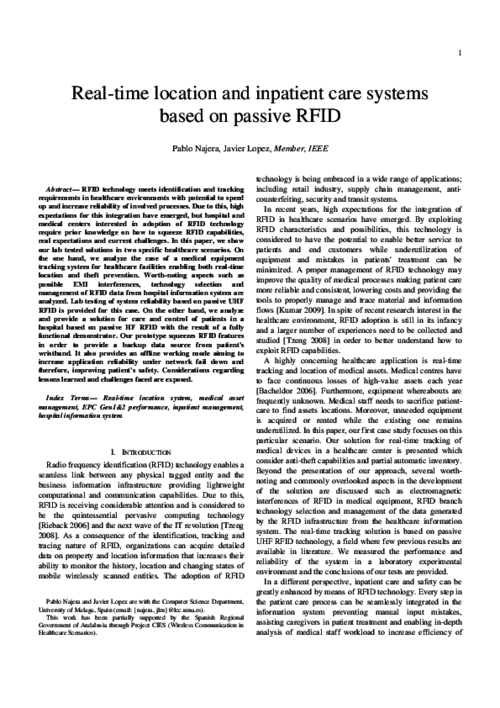
IEEE Computer, vol. 44, no. 9, IEEE, pp. 51 -58, Sept 2011. DOI
Abstract
This paper presents security of Internet of things. In the Internet of Things vision, every physical object has a virtual component that can produce and consume services Such extreme interconnection will bring unprecedented convenience and economy, but it will also require novel approaches to ensure its safe and ethical use. The Internet and its users are already under continual attack, and a growing economy-replete with business models that undermine the Internet’s ethical use-is fully focused on exploiting the current version’s foundational weaknesses.
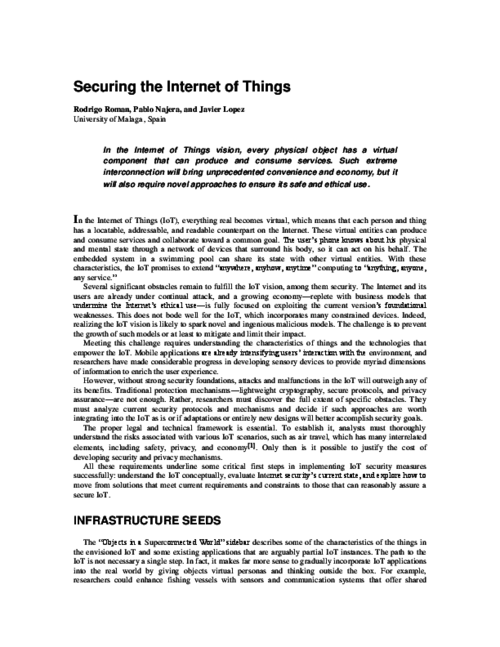
7th International Workshop on Security and Trust Management (STM’11), LNCS 7170, Springer, pp. 207-222, 2012. DOI
Abstract
The secure integration of RFID technology into the personal network paradigm, as a context-aware technology which complements body sensor networks, would provide notable benefits to applications and potential services of the PN. RFID security as an independent technology is reaching an adequate maturity level thanks to research in recent years; however, its integration into the PN model, interaction with other network resources, remote users and service providers requires a specific security analysis and a PN architecture prepared to support these resource-constrained pervasive technologies. This paper provides such PN architecture and analysis. Aspects such as the management of personal tags as members of the PN, the authentication and secure communication of PN nodes and remote users with the context-aware technologies, and the enforcement of security and privacy policies are discussed in the architecture.

Ad Hoc Networks, vol. 11, Elsevier, pp. 1091–1104, 2013. DOI
Abstract
The main objective of remote substations is to provide the central system with sensitive information from critical infrastructures, such as generation, distribution or transmission power systems. Wireless sensor networks have been recently applied in this particular context due to their attractive services and inherent benefits, such as simplicity, reliability and cost savings. However, as the number of control and data acquisition systems that use the Internet infrastructure to connect to substations increases, it is necessary to consider what connectivity model the sensor infrastructure should follow: either completely isolated from the Internet or integrated with it as part of the Internet of Things paradigm. This paper therefore addresses this question by providing a thorough analysis of both security requirements and infrastructural requirements corresponding to all those TCP/IP integration strategies that can be applicable to networks with constrained computational resources.
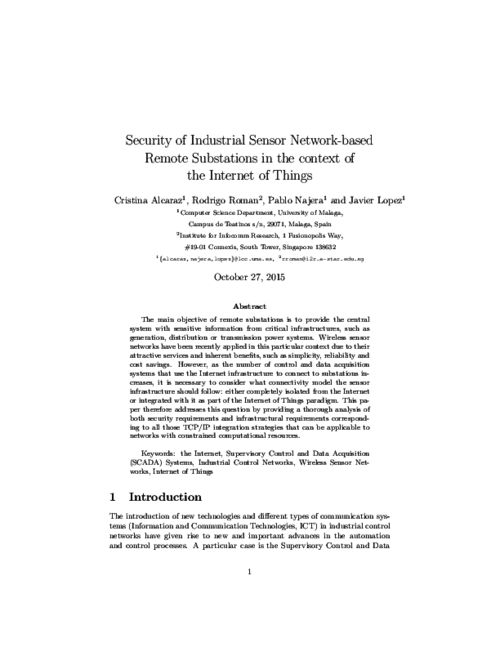
Security and Communication Networks, vol. 6, Wiley-Blackwell, pp. 1177–1197, Oct 2013. DOI
Abstract
A personal network (PN) should enable the collaboration of user’s devices and services in a flexible, self-organizing and friendly manner. For such purpose, the PN must securely accommodate heterogeneous technologies with uneven computational and communication resources. In particular, personal RFID tags can enable seamless recognition of user’s context, provide user authentication and enable novel services enhancing the quality and quantity of data handled by the PN. However, the highly constrained features of common RFID tags and their passive role in the network highlights the need of an adequate secure communication model with personal tags which enables their participation as a member of the PN. In this paper, we present our concept of PN, with special emphasis on the role of RFID and sensor networks, and define a secure architecture for PNs including methods for the secure access to context-aware technologies from both local PN members and the Internet of Things. The PN architecture is designed to support differentiated security mechanisms to maximize the level of security for each type of personal device. Furthermore, we analyze which security solutions available in the literature can be adapted for our architecture, as well as the challenges and security mechanisms still necessary in the secure integration of personal tags.
 ]
]